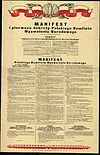Wikipedia:Today's featured article/October 19, 2005
The history of Poland from 1945 to 1989 was shaped by the influence of Soviet Communism and opposition to it from the Roman Catholic Church, trade unions and other groups. In the aftermath of the Second World War, forces of Nazi Germany were driven from Poland by the advancing Red Army of the Soviet Union. A liberalizing "thaw" in Eastern Europe followed the death of Stalin in early 1953, sparking the desire for further reform. However, de-Stalinization left Poland's Communist Party in a difficult position. In the 1970s, Edward Gierek's economic program brought a rise in living standards and expectations, but it faltered unexpectedly because of worldwide recession and increased oil prices following the 1973 world oil crisis. The election of John Paul II, a Pole, as Pope in 1978 triggered radical changes in the political atmosphere of the country. In 1980, electrician Lech Wałęsa and his independent "Solidarity" trade union led a wave of strikes at the Gdańsk Shipyards. In 1990 Wojciech Jaruzelski resigned as Poland's leader and was succeeded by Wałęsa. By the end of August, a Solidarity-led coalition government was formed, and in December Wałęsa was elected president; the Communist People's Republic of Poland became the Republic of Poland.
Recently featured: Colley Cibber – Seattle – Indian Railways

